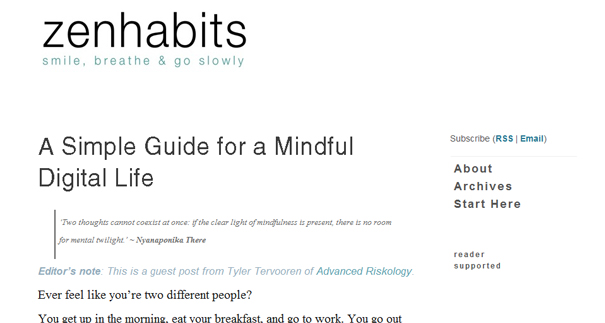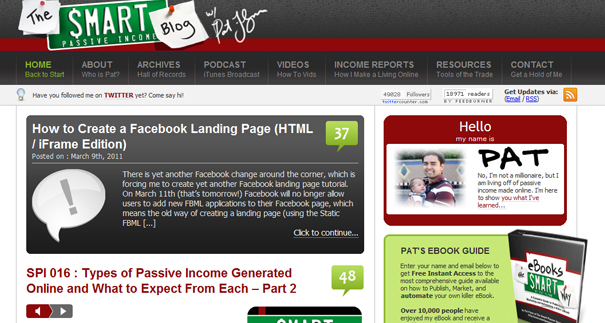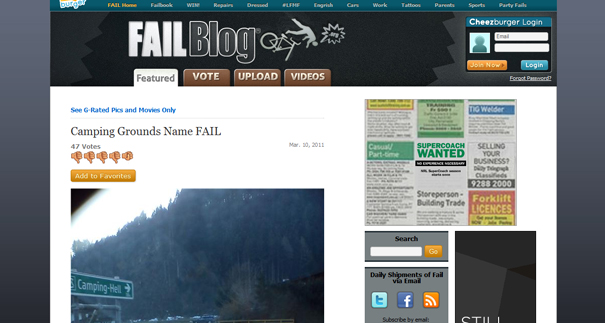This guest post is by Caz Makepeace of y Travel Blog.
Having success in the blogging world is attributed in large part to your own thinking and the mindset that you bring to this new avenue of making money.
Most people arrive here wanting to break free from the rut of a nine-to-five job that they’re no longer passionate about. The hours are long, the work is never-ending, and the pay is poor. Huh! On second thoughts, it sounds very similar to the beginnings of blogging.
What many people don’t realize is that the major hindrance to success in their blogging niche has nothing to do with technique or value, but with the job mentality that they have brought along with them.
Crossing over from a job to blogging is not just a physical move—it also involves a complete change in your mindset. It is a completely different world to what you’re used to in the cubicle farm. I often see arguments break out online which immediately make me wonder whether the people involved have an entrepreneurial mindset or a job mentality.
To cross over to the entrepreneurial world, you need to adopt the following ways of thinking.
Change is evolution
Job people become stuck in the way things are done, and always have been done. They are used to rules, schedules, and procedures. When they cross over into the blogging world, they discover that the rules have changed—and often, they can’t handle it.
Entrepreneurs understand that in the business world, the rules are always changing and if you don’t evolve with them, you’re going to die.
The major arguments that always emerge within the travel blogging community arise between those from the journalistic world and those bloggers whose success has had less to do with their linguistic ability than with their ability to market and network.
Really I just want to shout, “Listen up! The rules have changed. You are not in the journalist world any more. You are in the online world. The place where degrees and awards don’t matter. Anyone can start a website and have massive success with it. Whether you like it or not, doesn’t count. This is the reality of online marketing and building your own business. You either become an entrepreneur and adapt to the new world, or you sink—fast.”
How many highly successful entrepreneurs do you know who were never great at school and didn’t get a college degree? Let’s see. There’s Bill Gates, Andrew Carnegie, Walt Disney, Richard Branson … They have gotten where they are because of their entrepreneurial mindset. Entrepreneurs don’t try to fit the square peg into the round hole—they become a round peg instead.
Think big
Entrepreneurs think big and focus on the ultimate vision of what they are doing. They think outside of the box to look for new and unique ways to be successful and make money. They do not follow the herd. They watch and learn, and then say, “How can I make this better? How can I do this in a different, yet bigger way?” When you think outside the box, you create things that make you move above the crowd.
Job people concentrate only on the tasks at hand, and follow what most other people are doing. They are not used to focusing on the bigger picture as it has never been their vision to worry about. Bringing that limitation over to the entrepreneurial world can stifle your creativity and restrict your ability to handle and solve the many challenges that will arise.
Quitting becomes an easier option. Entrepreneurs know that the road to eventual wealth and success can be long and difficult, and the bigger vision helps move them through that period.
One of my favorite Donald Trump quotes is, “If you are going to be thinking anyway, you might as well be thinking big.” If you think small, you receive small.
We began our travel blogging world with the intention not to make a few ad bucks here and there, but to look towards a bigger picture that can lead us to earning vast amounts of income from many different sources. This bigger picture has an impact our strategy.
We haven’t made much money from our blog yet, and we’e okay with that. We have had success with the bigger picture we have focused on: building our brand and online presence, building a strong community, and networking with the right people. That will become our springboard for future projects that will bring in bigger rewards.
Self-promotion
I know people who are afraid to hand out their business cards, or tell people who they are and what they do. When you are able to do that confidently, you have made a big jump over into the entrepreneurial mindset.
No one is going to promote you for you. No one is going to care about what you have to offer more than you.
If you want to have success in an entrepreneurial world, you have to learn to promote yourself. Think of all the big brand people you know: Richard Branson, Donald Trump, Oprah Winfrey. What are all these people good at? Self-promotion.
Entrepreneurs are willing to do whatever it takes. Hand out those business cards, shake that person’s hand, and speak confidently about what you do and how you can offer value to others. Invite people to check out your website and connect with you via your networks. Share your work and successes.
You are guaranteed to receive criticism for doing this. Concentrate on your bigger picture and understand the criticism comes from those who want to do what you do, but have not yet broken free from the job mentality.
Networking is vital
Job mentality people tend to call this a “You scratch my back, I’ll scratch yours” kind of deal, and in some ways it is. But, in my entrepreneur mind, I never see it as being the case that if I do something for you, you have to do something for me in return.
It has more to do with building relationships and from those, interacting with those you like and trust. A natural extension of a relationship with someone you like and trust is to read their work, use their products, and recommend them to others. People do business with those they like and trust, just as they are friends with those they like and trust. There’s nothing shady about it.
Entrepreneurs immediately start building their networks of professional and business contacts. They understand the power and truth in the saying “It’s not what you know, it’s who you know.”
Networking is not just about what others can do for you, but what you can do for others. Being an entrepreneur means helping out others and providing value when you can. It means creating a mastermind group of people you can share and bounce ideas off of. You don’t hold your cards to your chest for fear of losing out and having others rise to the top over you.
Learn from those you want to be like
In the job world, we are taught that to move up the ladder and get that much-desired promotion, we need to prove we are better than the rest. It becomes a dog-eat-dog world: the knives come out and we are prepared to stomp all over those beside us in order to get to the finish line first.
Entrepreneurs have the intention to be the best at what they do; they are competitive and like to win. But, they know they don’t have to destroy others in the process. They understand that we each have a unique perspective or value that we can offer.
They understand that the best way to get to the top is to learn from those who are where you want to be. They don’t look at the person in the mansion on the hill and feel jealous. Instead, they find out that person’s name, they give them a call, and they say, “Hey. I really like what you have achieved. I want to be like you. How can I learn what you know?”
And usually that successful entrepreneur replies, “Well, how about we meet up for coffee and I can go over a few things with you?”
Entrepreneurs understand the concept of abundance. They understand what it takes to get to the top and they are more than happy to take the time to help someone do the same. As with everything in life, there will always be anomalies, but I have never met an entrepreneur yet who I have not had an interaction with that’s similar to what I have just described.
Making money is a good thing
“I think it’s scammy … dirty. I don’t want to ask for it. I feel funny asking for freebies.” These are just some of the comments I hear thrown around in the blogging world when it comes to making money.
I recently stayed in a hostel in Sydney free. It wasn’t really free, because in return for that I tweeted about the hostel the whole time I was there. I wrote a really great review of the place. I also wrote a couple of other spin-off articles on my site that linked to that piece. I promoted it through my social sites.
I had at least six people say to me that they would definitely stay in this hostel when they come to Sydney. That was on the day it was published, and from those who spoke. But let’s keep it at six and say that for one night’s stay in the dorm room where it costs $40, the hostel would earn $240. It cost them $140 to give us a private room for the night. We made them money.
Entrepreneurs think like this. They believe they can offer value and know they deserve to be rewarded for it. Because of this, they are not afraid to ask for the money and they don’t believe it’s dirty when they get it. They approach all transactions from a win-win perspective and there’s nothing bad about this.
On a similar level, I hear many bloggers say they feel they are selling out on their readers by selling advertising. Really? If your readers expect you to spend countless hours every day writing valuable content that informs and entertains, without receiving any compensation for it, then you need to get new readers.
Do you think they feel the same way when they pick up a magazine, a newspaper, or turn on the TV? Why do people think that when you enter the blogging world, suddenly you should start writing and work for nothing? If you have a job mentality then you may not get past these uncomfortable feelings of “selling out.”
You are doing this for the passion—yes! But you are also doing this for the income you originally craved so you could start living your life by your desires.
Think like an entrepreneur: “There is nothing wrong with making money. Making money enables me to move forward and grow, so I can in turn provide more value.”
If this article has struck a raw nerve with you, then ask yourself, “Could this perhaps be a sign that I have not yet crossed over?” Well … have you crossed over?
Caz Makepeace has been travelling and living around the world since 1997. Along with her husband Craig they are the founders of y Travel Blog. You can visit her Facebook Fan Page or sign up for herRSS Feed.
Post from: ProBlogger Blog Tips

Ditch the Job Mentality and Develop an Entrepreneurial Mindset


















.jpg)